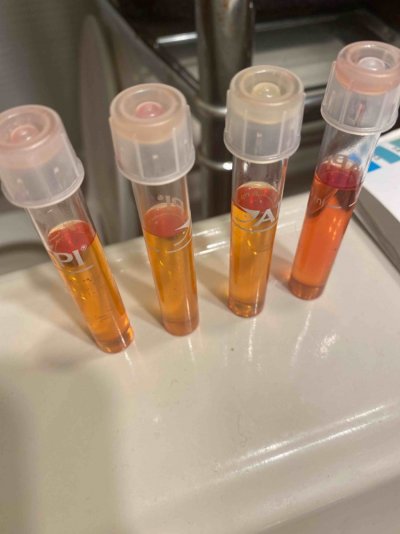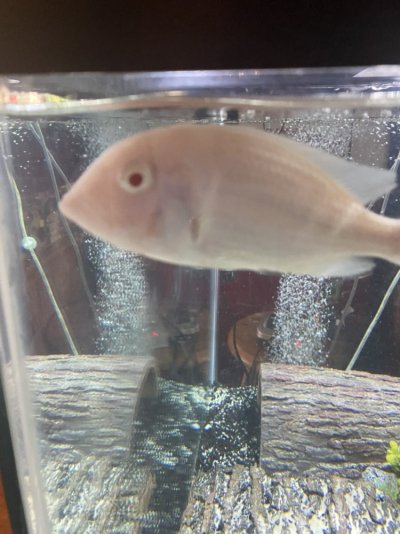Oh no... I just noticed something small white and stringy on the filter.... I think it might be from Jack from eating that little bit of Spirulina earlier. Of note, he hasn’t eaten anything since. [emoji20].
Is this a parasite? (I am assuming that was his poo because it didn’t look like a worm...) I just read a detailed post on something similar but it was dated. I will try to attach it here.They seemed to recommend Seachem Metroplex.
Gosh I’m so sad and scared.
Please help!!!i
View attachment 320159
Okay, this is an old thread, but Jack has been behaving like this- shows interest in food but will not eat...
(See below)
White stringy poo can either be a sign of an internal parasite (usually hex) or a bacterial infection.
If the fish is demonstrating, or has ever demonstrated, a combination of these ailments, then the diagnoses would lean towards hex.
1. Shows an interest in food but will not eat.
2. Taking a bite of the food and then spitting it out, without eating any of it
3. Staying to itself in a corner of the tank (when combined with the other mentioned symptoms).
4. White stringy poo, usually occurs after several days of not eating.
The treatment of choice would be a medication containing metrodonizole. My preference is SeaChem MetroPlex but I've also had success with API General Cure.
Since Metro is also an antibiotic, it would be the initial treatment recommendation. If this treatment does not provide results, then you should move on to treat with an antibacterial, either SeaChem KanaPlex or a combination treatment using Maracyn/Maracyn Two. Of these two, KanaPlex is the less expensive option. If ordering or purchasing KanaPlex, a 5g container sufficiently treats about 150 gallons. It is dosed every other day and you will need three treatments.
In either case, it would be best to dose the main tank as hex can spread, as can a bacterial ailment. Neither of the above mentioned medications will affect beneficial bacteria (if used according to the instructions).
100g- Oscar, Male Convict, 3 SDs - 20 gallon sump
55g - 20 Year Old Kissing Gourami + friends
55g - Pleco - 55g - Angelfish
29g Livebearer Community
4 Cats, 1 Sheltie, 1 wife, 1 old lady, and one of sub-adults broke back in.
kmuda
Joined: Fri Nov 27, 2009 11:17 am
Location: Fort Smith, Ar
Top
by DJRansome » Wed Jul 21, 2010 7:24 am
Try the bloat cures. But they take more than 48 hours, I'm sure sure what the med you used is. I always use metronidazole if I have to treat the main tank and clout if I have one very sick fish to treat in the hospital tank.
125G Borleyi, Multipunctata
75G Demasoni, Msobo, Lucipinnis
75G Calvus, Similis, Petricola
DJRansome
Global Moderator
Joined: Sat Oct 29, 2005 8:30 am
Location: Little Egg Harbor, NJ
Top
by limpert » Wed Jul 21, 2010 8:19 am
in regards to Metronidazole, should I use a form that is put in the water or should I use a food such as the Jungle Labs anti-parasite fish food which containts Metronidazole?
I am assuming that it is the form that is added to the water, and if this is the case, does petco or petsmart carry this?
(
http://www.petsmart.com/product/index.j ... erralID=NA )
limpert
Joined: Tue Aug 28, 2007 12:26 am
Location: Texas
Top
by kmuda » Wed Jul 21, 2010 8:24 am
If the fish is eating, a medicated food is good. If not, not so good. Generally, once a fish starts into the white stringy poop phase, they are not eating.
I've had good results just treating the water with both SeaChem MetroPlex and API General Cure.
100g- Oscar, Male Convict, 3 SDs - 20 gallon sump
55g - 20 Year Old Kissing Gourami + friends
55g - Pleco - 55g - Angelfish
29g Livebearer Community
4 Cats, 1 Sheltie, 1 wife, 1 old lady, and one of sub-adults broke back in.
kmuda
Joined: Fri Nov 27, 2009 11:17 am
Location: Fort Smith, Ar
Top
by triscuit » Wed Jul 21, 2010 8:32 am
I use FishZole, and the treatment I have had good success with is a 5 day, multiple doses and many water changes. So, while Jungle parasite clear Tank Buddies is an easy find option, you may want to order a larger quantity of metro for online.
triscuit
Joined: Thu May 05, 2005 9:49 pm
Location: Minnesota
Top
by limpert » Wed Jul 21, 2010 8:43 am
Thanks a ton for the quick replies.
I am looking at the SeaChem MetroPlex and am trying to figure out what quantity I will need for my 50 gallon tank.
limpert
Joined: Tue Aug 28, 2007 12:26 am
Location: Texas
Top
by DJRansome » Wed Jul 21, 2010 8:53 pm
To answer your question about food or water for med delivery, the fish that are not eating are really sick and get clout. The fish that are eating I just soak their regular NLS with met dissolved in water and dump in whatever is not absorbed by the food.
125G Borleyi, Multipunctata
75G Demasoni, Msobo, Lucipinnis
75G Calvus, Similis, Petricola
DJRansome
Global Moderator
Joined: Sat Oct 29, 2005 8:30 am
Location: Little Egg Harbor, NJ
Top
Hiding
by limpert » Fri Jul 23, 2010 8:02 pm
I dosed the food and water with the Seachem Metronidazole and all of the fish are now real jumpy. All of them are hiding under the rocks and whatnot. I still see the stringyness hanging from my albino zebra.
The directions for this stuff are not very detailed. How long should I leave this in the tank before doing a water change or treating again?
limpert
Joined: Tue Aug 28, 2007 12:26 am
Location: Texas
Top
by kmuda » Fri Jul 23, 2010 8:12 pm
I've never had a negative reaction using SeaChem MetroPlex. If you had a negative reaction, I would confirm you dosed per the instructions.
As for what you do, you continue on the path your on, unless you overdosed, in which case a partial water change is in order to lower the amount of medication in the tank.
Metro is dosed every 2 days, 2 measures per 10 gallons (with the little spoon in the container equaling 1 measure). I would go through three treatments before stopping treatment.
100g- Oscar, Male Convict, 3 SDs - 20 gallon sump
55g - 20 Year Old Kissing Gourami + friends
55g - Pleco - 55g - Angelfish
29g Livebearer Community
4 Cats, 1 Sheltie, 1 wife, 1 old lady, and one of sub-adults broke back in.
kmuda
Joined: Fri Nov 27, 2009 11:17 am
Location: Fort Smith, Ar
Top
by DJRansome » Sat Jul 24, 2010 7:53 am
The metronidazole treatment that has worked for me in bloat situations is different than the recommended dosage I think. Search for a post by cichlidaholic and click on the link in her signature.
125G Borleyi, Multipunctata
75G Demasoni, Msobo, Lucipinnis
75G Calvus, Similis, Petricola
DJRansome
Global Moderator
Joined: Sat Oct 29, 2005 8:30 am
Location: Little Egg Harbor, NJ
Top
by Robin » Sat Jul 24, 2010 12:48 pm
I'll just throw this out there:
are you sure it's feces you're seeing?
Camallanus/parasitic nematodes worms look like hairs and protrude out of the anus. I believe if you watch the worms will occasionally go back in.
Just where you said hair-like feces it made think of these worms.
Robin
BLOAT:
https://www.cichlid-forum.com/phpBB/view ... hp?t=24132
https://www.cichlid-forum.com/articles/m ... t2_pt1.php
ICK:
https://www.cichlid-forum.com/articles/ich.php
IS YOUR DECHLORINATOR WORKING?
http://www.thetropicaltank.co.uk/rev-cond.htm
Robin
Joined: Tue Sep 17, 2002 8:00 pm
Location: Maine
Top
by limpert » Sun Jul 25, 2010 1:34 pm
I am 99% sure that this is not cammallanus. I previously treated with Levamisole which proved to be ineffective, not to mention that cammallanus worms are typically red. To your point about whether or not it is feces, it is clearly not, i was just having trouble describing what I was seeing.
On a good note, it appears that there is some improvement. Last night I added some Epsom salt to the tank and this morning I no longer saw the stringy item hanging from the fish. I think i will continue treatment with water changes every 2 days for a week.
Also, i have been soaking their food in metro dissolved in water like DJ said. Fingers crossed, knock on wood, it seems to be working
limpert
Joined: Tue Aug 28, 2007 12:26 am
Location: Texas
Top
by limpert » Thu Aug 05, 2010 6:07 pm
ITS BACK
It appears that it is back after metro treatment... Where should i go from here?
by kmuda » Thu Aug 05, 2010 7:06 pm
That would normally be an indication of a metro treatment that did not last long enough or did not include enough medication, and when dosing the food, it's pretty easy to make either mistake, or to overdose.
And while I freely admit that dosing the food is the best option, doing so does not always allow getting the correct dosage.
I would recommend going back to another round of Metro treatment, using SeaChem MetroPlex, and dosing the water per the provided instructions.
100g- Oscar, Male Convict, 3 SDs - 20 gallon sump
55g - 20 Year Old Kissing Gourami + friends
55g - Pleco - 55g - Angelfish
29g Livebearer Community
4 Cats, 1 Sheltie, 1 wife, 1 old lady, and one of sub-adults broke back in.
kmuda
by triscuit » Thu Aug 05, 2010 9:12 pm
I have never tried dosing the food- instead I dose the whole tank, for a 5 day treatment. In all cases of intestinal disease, the only times it didn't come back was when the fish were not fed at all during the treatment. Food in the gut can harbor microorgansims.
Considerations with using any biocide like metro are to make sure you balance dosing strongly enough to kill harmful pests and long enough to avoid encouraging resistance to metro, while ensuring that the treatment isn't worse than the disease (I've only ended with dead fish when I've used Clout).
FYI, it's important to consider the pH of your tank when dosing with metro. Reports from use in aquaculture suggest that in alkaline waters, metro becomes inert after a few hours. I've used the following technique on catfish, mbuna, cyps, paracyps, gobies, julies, calvus, xenos etc with no deaths during treatment.
This is the regimen for a 55 gallon tank:
Do not feed your fish at all during the treatment.
Day 1: Dissolve and add 5 tablets Fishzole (each tab has 250 mg of metro), and 1/2 cup dissolved epsom salt to the tank.
Day 2: 5 tabs in the AM, then 40% WC and 5 tabs in the evening (added another 1/3 cup of epsom salt).
Day 3: 5 tabs in the AM, 5 tabs in the PM.
Day 4: 40% WC (with 1/3 cup epsom salt) and 5 tabs in the AM, and 5 tabs in the PM.
day 5: 40% WC
Day 6: 40% WC and feed lightly


